In the QS World University Rankings 2011 of the world’s 400 most respected universities, not a single one of India’s 603 universities or 31,000 colleges is ranked among the top 200. And in the THE World University Rankings, none of India’s institutions of higher education is ranked among the Top 300. Dilip Thakore reports
.gif) A heavy pall of conspiratorial silence hangs over Indian academia, the all-powerful Union ministry of human resource development and its handmaiden supervisory agencies including the University Grants Commission (UGC), National Assessment and Accreditation Council (NAAC) etc, following publication of damning global surveys of the world’s best universities by the highly-respected London-based education research agency Quacquarelli Symonds Ltd (QS, estb. 1988) and the well-reputed Times Higher Education weekly (THE, estb. 1964).
A heavy pall of conspiratorial silence hangs over Indian academia, the all-powerful Union ministry of human resource development and its handmaiden supervisory agencies including the University Grants Commission (UGC), National Assessment and Accreditation Council (NAAC) etc, following publication of damning global surveys of the world’s best universities by the highly-respected London-based education research agency Quacquarelli Symonds Ltd (QS, estb. 1988) and the well-reputed Times Higher Education weekly (THE, estb. 1964).
In the QS World University Rankings 2011 of the 400 most respected universities released on September 5, not a single one of India’s 603 universities or 31,000 colleges is ranked among the top 200. And in the THE World University Rankings, none of India’s institutions of higher education is ranked among the Top 300, despite the subcontinent boasting university education way back in the sixth century in the ancient universities of Nalanda and Taxila, and the metropolitan universities of Bombay, Calcutta and Madras being of 150 years-plus vintage. India’s top-ranked ‘university’ in the QS Top 400 league table is the Indian Institute of Technology, Delhi (IIT-Delhi) ranked 218 followed by IIT-Bombay (225) and IIT-Madras (281). In the THE World University Rankings 2011-12, the top-ranked institution is IIT-Bombay, awarded a non-specific rank of 301-350.
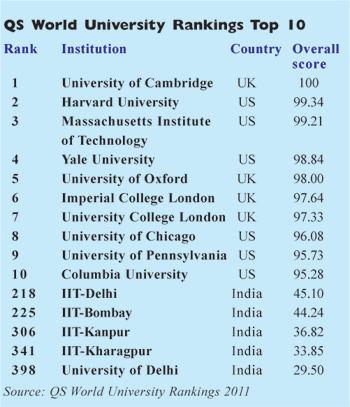 By including the IITs — which as specialist engineering and technology institutions are not universities by definition — QS and THE (which together initiated the world university league tables/rankings in 2005 but went their separate ways in 2009) have been generous, swayed perhaps by global hype and blah about the world’s largest democracy, fastest-growing economy, emerging superpower etc. Because if the IITs were excluded from the world university rankings as they should have been, India’s top-ranked university — defined as a multi-disciplinary higher education institution — is Delhi University (DU, estb.1922) which just about squeezes into the Top 400 QS league table with a 398th ranking. In the THE 2011-12 league table, DU is unranked. More significantly, the global reputation of India’s numero uno university has been slipping contin-uously. In 2007, it was ranked No. 254 in the joint THE-QS global league table; 274 in 2008; 291 in 2009 (QS); 371 in 2010 and 398 this year.
By including the IITs — which as specialist engineering and technology institutions are not universities by definition — QS and THE (which together initiated the world university league tables/rankings in 2005 but went their separate ways in 2009) have been generous, swayed perhaps by global hype and blah about the world’s largest democracy, fastest-growing economy, emerging superpower etc. Because if the IITs were excluded from the world university rankings as they should have been, India’s top-ranked university — defined as a multi-disciplinary higher education institution — is Delhi University (DU, estb.1922) which just about squeezes into the Top 400 QS league table with a 398th ranking. In the THE 2011-12 league table, DU is unranked. More significantly, the global reputation of India’s numero uno university has been slipping contin-uously. In 2007, it was ranked No. 254 in the joint THE-QS global league table; 274 in 2008; 291 in 2009 (QS); 371 in 2010 and 398 this year.
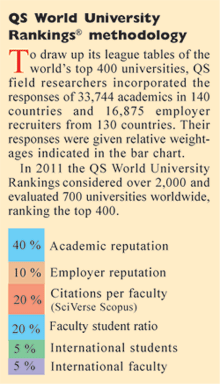 Although typically, Union HRD minister Kapil Sibal remains supremely indifferent to the rock-bottom reputation of India’s higher education system (repeated efforts to elicit a response from him proved futile), and given the tacit acceptance by Indian academia of Western superiority, perhaps the most unkindest cut of all is that a host of parvenu Asian universities are ranked well above India’s top-ranked Delhi University. Fifty-seven Japanese and 40 Chinese universities are included in the QS Top 400 league table as against only 11 (including the IITs) from India, which had a headstart in higher education in Asia with the universities of Bombay, Calcutta and Madras chartered in 1857, when the East India Co ceded suzerainty over its Indian territories to the British crown.
Although typically, Union HRD minister Kapil Sibal remains supremely indifferent to the rock-bottom reputation of India’s higher education system (repeated efforts to elicit a response from him proved futile), and given the tacit acceptance by Indian academia of Western superiority, perhaps the most unkindest cut of all is that a host of parvenu Asian universities are ranked well above India’s top-ranked Delhi University. Fifty-seven Japanese and 40 Chinese universities are included in the QS Top 400 league table as against only 11 (including the IITs) from India, which had a headstart in higher education in Asia with the universities of Bombay, Calcutta and Madras chartered in 1857, when the East India Co ceded suzerainty over its Indian territories to the British crown.
Despite this, in the QS Asian Universities 2011 league table headed by the Hong Kong University of Science & Technology (estb. 1991), University of Hong Kong (1911) and National University of Singapore (1905), the top-ranked Indian institution of higher education is IIT-Kanpur (no. 36) followed immediately by IIT-Delhi and IIT-Bombay. South Korea’s Seoul University (estb. 1946) at no. 6 and the Korean Advanced Institute of Science and Technology (KAIST, estb. 1971) at no. 11, are ranked way above India’s handful of passably world-class varsities.
Only in the science, technology, engineering and mathematics (STEM) subjects do Indian higher education institutions secure fairly respectable rankings. In computer sciences, IIT-Delhi is ranked no. 43, IIT-Bombay no. 50 and IIT-Kanpur and IIT-Madras within the global 100. IIT-Kharagpur and Delhi University are ranked within the Top 150 for this subject specialisation, followed by the more-than-century old Indian Institute of Science (IISc. estb.1908). For arts and humanities education, DU is ranked no. 25 and the University of Calcutta no. 54 in Asia.
 Even though India’s thick-skinned politicians and complacent academics are indifferent about the mediocrity of India’s best and self-proclaimed world-class universities, presumably because this country has an estimated 550 million youth aged below 24 and as such offers the largest cohort of working-age popu-lation globally, Nunzio Quacquarelli, the London-based promoter-managing director of Quacquarelli Symonds, is concerned about the low ranking of India’s higher education institutions. “The global reputation of India’s universities as reflected in the QS World University Rankings 2011 is disapp-ointing. Despite huge interest in education in India, the university system seems mired in tradition and bureaucracy. There are of course examples of excellence among the IITs and IIMs, and some private universities seem genuinely committed to achieving international standards. But to facilitate change and improvement, there is urgent need for greater transpar-ency in measuring the performance of Indian universities,” says Quacquarelli.
Even though India’s thick-skinned politicians and complacent academics are indifferent about the mediocrity of India’s best and self-proclaimed world-class universities, presumably because this country has an estimated 550 million youth aged below 24 and as such offers the largest cohort of working-age popu-lation globally, Nunzio Quacquarelli, the London-based promoter-managing director of Quacquarelli Symonds, is concerned about the low ranking of India’s higher education institutions. “The global reputation of India’s universities as reflected in the QS World University Rankings 2011 is disapp-ointing. Despite huge interest in education in India, the university system seems mired in tradition and bureaucracy. There are of course examples of excellence among the IITs and IIMs, and some private universities seem genuinely committed to achieving international standards. But to facilitate change and improvement, there is urgent need for greater transpar-ency in measuring the performance of Indian universities,” says Quacquarelli.
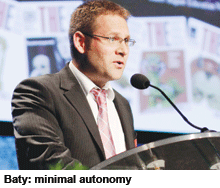 Phil Baty, editor of the THE World University Rankings also identifies excessive government control and the minimal autonomy of India’s varsities as one of the prime causes of their conspicuous absence from the THE league table of Top 300 universities. “The universities that tend to do very well in world rankings enjoy high levels of autonomy, and are free from excessive control and bureaucratic processes. The best universities have to be entrep-reneurial, fast moving and dynamic. This needs freedom,” says Baty, implying that Indian universities lack this vital attribute. “The key is to transform India’s incredible economic power into developing not just world-class universities, but a truly strong mass higher education system,” he adds.
Phil Baty, editor of the THE World University Rankings also identifies excessive government control and the minimal autonomy of India’s varsities as one of the prime causes of their conspicuous absence from the THE league table of Top 300 universities. “The universities that tend to do very well in world rankings enjoy high levels of autonomy, and are free from excessive control and bureaucratic processes. The best universities have to be entrep-reneurial, fast moving and dynamic. This needs freedom,” says Baty, implying that Indian universities lack this vital attribute. “The key is to transform India’s incredible economic power into developing not just world-class universities, but a truly strong mass higher education system,” he adds.
Within Indian academia, the standard response to the pathetic standards of higher education institutions which prompt an estimated 100,000 post-secondary students to flee to expensive universities in Europe and the US every year, is that international rating and ranking agencies including QS and THE don’t know the intricacies of India’s higher education system or institutions and universities to do them justice. Yet it is pertinent to note that these annual surveys are year-long exercises involving massive expenditure and comprehensive investigation. For instance, to constitute its master league table for the QS World University Rankings 2011, the company’s field researchers interviewed 33,744 acad-emics and 16,875 graduate employers globally to evaluate 2,000 universities worldwide, of whom the Top 400 are ranked. Moreover, the evaluation methodology which accords 40 percent weightage to academic reputation; 10 percent to the reputation of companies/employers hiring graduates; 20 percent to citations per faculty (as per SciVerse Scopus data); 20 percent to faculty-student ratio and five percent each to proportion of international faculty and students, is apposite for the newly emergent globalised economy, and rationally irrefutable.
.gif) Nevertheless the great majority of indigenous academics insist that the parameters adopted by QS and THE are inappropriate for assessing Indian universities. “There is no doubt that our institutions of higher learning need to improve significantly to attain respectable positions in the world university rankings. But examined critically the methodology, parameters and relative weightages given to different metrics of the ranking process, many are not ‘global’. For example, the weightage given to international faculty and students, and Nobel Prizes and field medals awarded to faculty as also to publication of papers in western public-ations such as Nature and Science, is out of sync with the aims and objectives of Indian universities, which are also presumed to have very adverse student faculty ratios because of our colleges affiliation system. Therefore given this lack of commonalities, it’s not surprising that Indian universities are poorly ranked in these league tables,” says Prof. H.A. Ranganath, former vice chancellor of Bangalore University and currently director of NAAC, an auto-nomous organisation of UGC, given the mandate to assess and rank all higher education institutions. Unfortunately NAAC assessment and accreditation is a voluntary option of higher education institutions, and thus far NAAC has ranked only 4,371 colleges and 161 universities countrywide. Significantly, Delhi University has not volunteered for NAAC assessment.
Nevertheless the great majority of indigenous academics insist that the parameters adopted by QS and THE are inappropriate for assessing Indian universities. “There is no doubt that our institutions of higher learning need to improve significantly to attain respectable positions in the world university rankings. But examined critically the methodology, parameters and relative weightages given to different metrics of the ranking process, many are not ‘global’. For example, the weightage given to international faculty and students, and Nobel Prizes and field medals awarded to faculty as also to publication of papers in western public-ations such as Nature and Science, is out of sync with the aims and objectives of Indian universities, which are also presumed to have very adverse student faculty ratios because of our colleges affiliation system. Therefore given this lack of commonalities, it’s not surprising that Indian universities are poorly ranked in these league tables,” says Prof. H.A. Ranganath, former vice chancellor of Bangalore University and currently director of NAAC, an auto-nomous organisation of UGC, given the mandate to assess and rank all higher education institutions. Unfortunately NAAC assessment and accreditation is a voluntary option of higher education institutions, and thus far NAAC has ranked only 4,371 colleges and 161 universities countrywide. Significantly, Delhi University has not volunteered for NAAC assessment.
Dr. Ram Marayan, vice chancellor of the Manipal and Bangalore-based Manipal University (estb. 1942) — the country’s most respected private university — offers another explanation for the declining reputation of Indian universities in international league tables. “Indian universities are essentially teaching institutions whereas foreign ranking agencies accord heavy weightage to research activity and citations in academic journals. This is because over half a century ago, the Central govern-ment shifted major R&D (research and development) activities to specialist research institutes such as CISR (Central Institute for Scientific Research), IISc and TIFR (Tata Institute of Fundamental Research), thereby discouraging R&D in universities. In Manipal University, we are actively engaged with applied research in the health sciences and have increased pure research initiatives because we acknowledge that it improves teaching and learning outcomes,” says Ram Narayan.
Nevertheless, it is pertinent to note that the QS varsities assessment methodology accords major weightage (40 percent) to ‘academic reputation’; and a mere 10 percent to international-isation and 20 percent to research and citations. Therefore it’s difficult to gloss over the hard reality that the major cause of the rock-bottom global reputation of Indian universities is academic failure — hardly a national secret which has been detailed and dissected ad naus-eam, particularly in EducationWorld.
 Three years ago when Delhi University was ranked no.274 in the joint THE-QS World University Rankings 2008, this publication wrote a lead feature exploring the factors behind the pre-eminence in India of DU, deriving in the main, that as a Central University, it is (relatively) well-funded by the Union government, and the University Grants Commission in particular (see EW February 2009). Since then, the conti-nuous slide in academic standards in Indian education has been consistently monitored by this publication — the country’s sole education news and analysis magazine — which completed 12 years of uninterrupted publishing last month.
Three years ago when Delhi University was ranked no.274 in the joint THE-QS World University Rankings 2008, this publication wrote a lead feature exploring the factors behind the pre-eminence in India of DU, deriving in the main, that as a Central University, it is (relatively) well-funded by the Union government, and the University Grants Commission in particular (see EW February 2009). Since then, the conti-nuous slide in academic standards in Indian education has been consistently monitored by this publication — the country’s sole education news and analysis magazine — which completed 12 years of uninterrupted publishing last month.
Given pervasive inertia and falling standards in Indian education, acade-mics might be expected to spark a debate about higher education reform within this publication. Yet we have never received a letter of rebuttal, explanation or contradiction from any of the dons of Indian academia. Virulent criticism notwithstanding, in their ivory towers it’s business as usual. Never mind that a NASSCOM-McKinsey World Insti-tute report (2005) alleges that 75 percent of engineering and 85 percent of arts, science and commerce graduates of the 31,000 colleges affiliated with India’s 603 universities are unemployable in organised sector corporate enterprises.
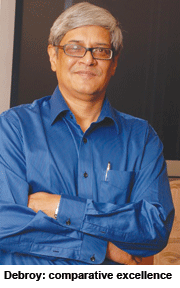 The high degree of complacency and lack of accountability prevalent in Indian academia is reflected in the stony refusal of Dr. Dinesh Singh, vice chancellor of Delhi University, to respond to a rain of e-mails and telephone calls to comment upon the rock-bottom ranking of DU in the QS and THE league tables. Presu-mably content that it’s the country’s premier varsity with some of its affiliated colleges stipulating 98-100 percent in Plus Two as admission cut-offs, Singh seems to discern no need to be answerable for DU’s pathetic global reputation.
The high degree of complacency and lack of accountability prevalent in Indian academia is reflected in the stony refusal of Dr. Dinesh Singh, vice chancellor of Delhi University, to respond to a rain of e-mails and telephone calls to comment upon the rock-bottom ranking of DU in the QS and THE league tables. Presu-mably content that it’s the country’s premier varsity with some of its affiliated colleges stipulating 98-100 percent in Plus Two as admission cut-offs, Singh seems to discern no need to be answerable for DU’s pathetic global reputation.
Yet even if DU is India’s premier — and most favoured — varsity, its primacy is akin to that of a cactus in the desert. “Delhi University is basking in the glory of the number of desperate youth seeking admission into it. But it’s an excellent institution only in compa-rison with really bad Indian varsities such as Patna University and the like. In reality, it is too large and unwieldy, lacks autonomy and has a poor research record. It urgently needs a shake-up and structural change,” says Bibek Debroy, the well-known Delhi-based economist and fellow of the Centre for Policy Research.
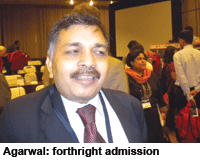 Pawan Agarwal, education advisor to the Planning Commission, forthrightly admits the need to reshape the character and priorities of Indian universities. “There are three reasons for the poor international reputation of Indian universities as reflected in the world rankings. First, in terms of postgraduate and doctoral enrolments, they tend to be much smaller than most ranked universities. Secondly, the rankings measure research performance and Indian universities need to do a lot more to improve their research profiles. And finally, Indian universities don’t attract foreign students or faculty. We need to address all three areas, to have at least few of our universities in the global top league,” says Agarwal.
Pawan Agarwal, education advisor to the Planning Commission, forthrightly admits the need to reshape the character and priorities of Indian universities. “There are three reasons for the poor international reputation of Indian universities as reflected in the world rankings. First, in terms of postgraduate and doctoral enrolments, they tend to be much smaller than most ranked universities. Secondly, the rankings measure research performance and Indian universities need to do a lot more to improve their research profiles. And finally, Indian universities don’t attract foreign students or faculty. We need to address all three areas, to have at least few of our universities in the global top league,” says Agarwal.
Fortunately, within a small circle of knowledgeable monitors of 21st century India’s crumbling higher education system, there is awareness that India’s higher education system needs bold reforms and trans-formation. Privately and off the record, most genuine academics attribute the poor performance and reputation of the country’s universities to stifling burea-ucratic controls, which have almost wholly eroded their autonomy. The few that have fought for and wrested a measure of autonomy from the ubiquitous neta-babu kleptocracy — IITs, Indian Institute of Science — are precisely the ones which have made it into the QS and THE league tables.
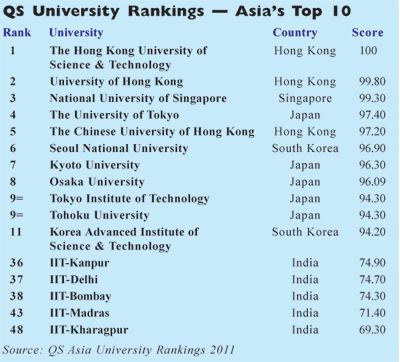 Indeed the span and range of controls imposed upon universities by the Union HRD ministry and its agencies such as UGC and AICTE (All India Council for Technical Education), packed with politically appointed academics of dubious repute with paper qualifications from obscure upcountry universities, is astonishing and perhaps unique worldwide. All study programmes have to be approved by UGC and/or AICTE, a laborious process which discourages upgradation and revision of syllabuses; and faculty appointments are heavily influenced by politically appointed shallow academics inducted into university syndicates and senates.
Indeed the span and range of controls imposed upon universities by the Union HRD ministry and its agencies such as UGC and AICTE (All India Council for Technical Education), packed with politically appointed academics of dubious repute with paper qualifications from obscure upcountry universities, is astonishing and perhaps unique worldwide. All study programmes have to be approved by UGC and/or AICTE, a laborious process which discourages upgradation and revision of syllabuses; and faculty appointments are heavily influenced by politically appointed shallow academics inducted into university syndicates and senates.
With promotions linked to seniority and faculty not accountable for learning outcomes, it’s hardly a wonder that since Sir C.V. Raman and Rabindranath Tagore won the Nobel Prize for science and literature in the 1930s, no Indian academic has ever won a worthwhile international award. Neither can one recall any significant invention or process which has emerged from India’s university system in the past decades. In particular, Indian academia — which absorbs a not insubstantial Rs.80,000 crore of the annual national outlay (Centre plus states) — bears a heavy responsibility for having failed to develop the country’s abundant solar energy resource, boost agricultural productivity after the Green Revolution of the 1960s, or devise meaningful solutions for resolving chronic child malnutrition and pervasive illiteracy.
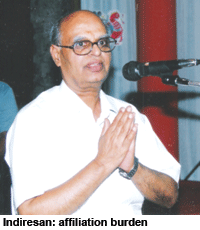 Dr. P.V. Indiresan, the highly respected former director of IIT-Madras and IIT-Delhi, confirms that the root cause of the underperformance in world rankings of Indian higher education, is heavy depen-dence on government, and political interference. “India’s universities aren’t adequately funded and therefore lack quality faculty and research culture. Moreover every university is burdened with hundreds of affiliated colleges with the result that most faculty time is spent on teaching, administration, and conducting examinations. As a result university professors have very little time for research work. One of the first priorities of a reform agenda for higher education should be abolition of the affiliation system and decreeing every college autonomous. I have been advocating this for years, but unfortunately nobody in government pays any heed to the opinions of academics,” laments Indiresan.
Dr. P.V. Indiresan, the highly respected former director of IIT-Madras and IIT-Delhi, confirms that the root cause of the underperformance in world rankings of Indian higher education, is heavy depen-dence on government, and political interference. “India’s universities aren’t adequately funded and therefore lack quality faculty and research culture. Moreover every university is burdened with hundreds of affiliated colleges with the result that most faculty time is spent on teaching, administration, and conducting examinations. As a result university professors have very little time for research work. One of the first priorities of a reform agenda for higher education should be abolition of the affiliation system and decreeing every college autonomous. I have been advocating this for years, but unfortunately nobody in government pays any heed to the opinions of academics,” laments Indiresan.
It’s patently clear that the college affiliation system has hollowed out India’s universities, transforming them from postgraduate teaching and research hubs into administrative institutions. Currently, the University of Mumbai has 354 colleges across the state affiliated with it with an aggregate enrolment of 600,000 students; and Bangalore University has 800 affiliated colleges. In a special report feature written in September 2005 EducationWorld exposed the ‘Curse of the university affiliation system’.
In the feature the late Dr. Anil Wilson, for many years the highly respected principal of St. Stephen’s College, Delhi — the country’s premier liberal arts college — excoriated the colleges affiliating system. “It has outlived its purpose. The sheer size to which universities have grown is the biggest pitfall. But, is anyone listening? Dinosaurs became extinct because of their big size; the same applies to Indian universities. With the size of universities growing, it adversely affects their academic capability, administrative structure and related work. Conseq-uently academic improvement and excellence is neglected. The affiliation system has produced non-productive structures that impede quality educa-tion,” he told EW six years ago.
.gif) The persistence of the affiliation system is connected with the way-below-cost tuition fees imposed upon universities by the Central and state governments. College affiliation has become a major revenue stream, especially for cash-strapped state government funded universities in which as a populist gesture, tuition fees have been frozen since indepen-dence. With affiliation fees ranging from Rs.3-10 lakh, and annual state govern-ment grants sufficient only to cover faculty and staff salary bills, it’s unsurprising that Bangalore University boasts 800 affiliated colleges and University of Mumbai 354, many of them of dubious academic repute.
The persistence of the affiliation system is connected with the way-below-cost tuition fees imposed upon universities by the Central and state governments. College affiliation has become a major revenue stream, especially for cash-strapped state government funded universities in which as a populist gesture, tuition fees have been frozen since indepen-dence. With affiliation fees ranging from Rs.3-10 lakh, and annual state govern-ment grants sufficient only to cover faculty and staff salary bills, it’s unsurprising that Bangalore University boasts 800 affiliated colleges and University of Mumbai 354, many of them of dubious academic repute.
An obvious solution to shoring up the precarious financial condition of India’s universities and colleges, which makes them pathetically dependent upon government handouts, is to raise tuition fees. But despite governments the world over, Britain, China and Chile (see international news p.64) included, having sharply raised tuition fees in publicly-funded higher education institutions, this is a taboo subject in India’s political and social discourse.
Curiously, neither the country’s 13 million college and university students nor the middle class which has grabbed most of the inadequate collegiate capacity prompting an elaborate system of reservation or affirmative action for socio-economically backward classes/castes, seem unduly perturbed that the outcome of the low tuition fees regime (it contributes barely 10 percent towards the annual expenditure of universities and colleges) is poor quality higher education. Comments Dr. Neeraj Kaushal, the US-based associate professor of social work at Columbia University in a column in Education-World (November 2010): “Students neither expect nor demand rigorous education and remain indifferent to the quality of teaching dispensed. Clearly, if their financial stake was higher, they would be more demanding. The result of all this is that Indian society is trapped in a low-price low-quality higher education equilibrium.”
Against this backdrop, clearly the biggest hit that Indian universities and higher education in general has taken in the QS and THE World University Rankings is under the academic reputation parameter. Unfortunately Indian academia is swamped with career academics only too willing to be co-opted into the graft-ridden “low-price low-quality higher education equili-brium” system haphazardly devised by post-independence India’s dominant political class which has scant respect or regard for notions such as academic excellence or autonomy.
.gif) “The principles of academic autonomy are not only applicable to institutions but also to individuals in positions of authority within them. The poor reputation of Indian universities is in a large measure due to the unwillingness of academic leaders and faculty to prevent meddling by IAS bureaucrats and ignorant politicians in higher education. There’s no shortage of academics and eminent professors who for top-level positions and petty favours, are ready to permit erosion of the autonomy of their institutions. To restore the glory and prestige of the country’s institutions of higher educa-tion, the academic community needs to reclaim its self-respect and leadership status in education,” says Dr. A.S. Seetharamu, former professor of education at the Institute of Social and Economic Change, Bangalore and currently an advisor to the Karnataka government.
“The principles of academic autonomy are not only applicable to institutions but also to individuals in positions of authority within them. The poor reputation of Indian universities is in a large measure due to the unwillingness of academic leaders and faculty to prevent meddling by IAS bureaucrats and ignorant politicians in higher education. There’s no shortage of academics and eminent professors who for top-level positions and petty favours, are ready to permit erosion of the autonomy of their institutions. To restore the glory and prestige of the country’s institutions of higher educa-tion, the academic community needs to reclaim its self-respect and leadership status in education,” says Dr. A.S. Seetharamu, former professor of education at the Institute of Social and Economic Change, Bangalore and currently an advisor to the Karnataka government.
Meanwhile even as the student and academic communities and the country’s inert middle class seem content with the status quo, and indifferent to the reality that even the country’s best universities are slipping in the QS and THE global league tables, Indian society and the economy is paying a terrible price for the neglect of its education system. Postgraduate training costs of Indian industry are arguably the highest worldwide, despite which shop-floor and managerial productivity of India Inc is an estimated 30 percent of workers and managers in developed OECD countries. In the agriculture sector — which employs 67 percent of the population — the highest foodgrain per hectare yields of Punjab are half the average of Chinese and one-fourth of US farmers. Little wonder that chronic inflation prompted by supply-side inadequacies and post-production mismanagement and losses are a way of life in contemporary India, foolishly projected as a new superpower of the 21st century.
The official response to the mess in Indian higher education is to introduce a super-empowered National Commission for Higher Education and Research (NCHER) to supervise all institutions of higher education; and a Foreign Educational Institutions (Regulation of Operations and Entry) Bill to permit foreign universities to establish campuses and outposts in India. But informed opinion is that the NCHER will further bureau-cratise and circumscribe the autonomy of higher education institutions (see EW February 2011 special report), and the FEI Bill sets conditions which are too stringent to induce the best foreign universities to meaningfully plant their flags in India (see EW July 2010 special report).
In this scenario of academic complacency, students’ indifference, political ham-fistedness, and societal neglect, the future of India’s struggling universities looks bleak. With higher education institutions in neighbouring Asian countries, China and Korea in particular, outstripping India’s best universities in terms of learning outcomes and research output, the historic advantage this country has enjoyed in terms of a head start in higher education, English language advantage and demographics, is likely to be nulli-fied in the near future. The best prescription for stemming the rot is for a righteous coalition of the academic community, Indian industry (suffering a talent crunch and poor produc-tivity) as also middle class India to speak up and wrest control of the country’s beleaguered univ-ersities and higher education institutions from the neta-babu stranglehold.
The soft option is to ignore the downward spiral of India’s best universities in the QS and THE rankings and advance hair-splitting arguments that ignorant foreigners don’t adequately understand India’s complex higher education system. But in the newly emerging global economy where investment, resources and consumer loyalties will rapidly migrate towards economies with skilled and high productivity manpower, such inertia is fraught with grave consequences for a nation which grudgingly hosts the world’s largest child population.
With Meeta Sengupta (Delhi)